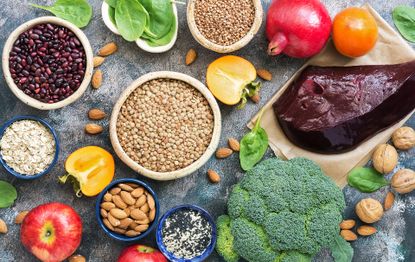Foods high in iron: How much iron is there in these common foods?
Getting enough iron in foods is crucial, but how do you figure out how much is on your plate?


What is iron?
Getting enough iron in foods is crucial, but how do you figure out how much is on your plate?
Iron is a mineral that plays lots of different roles in the body, from maintaining a healthy immune system to transporting oxygen around the body. If you’re not getting enough foods high in iron, you might feel tired and low in energy.
According to dietitian Dr Carrie Ruxton, iron is vital for many parts of a healthy, functioning body. She told GoodtoKnow, "Iron is an essential component of haemoglobin, which is the carrier for oxygen in our blood. Iron also supports muscle function, immune function and cognitive function. Low iron levels can lead to breathlessness, fatigue, poor concentration and a higher risk of picking up colds and infections. "
Iron deficiency can also put you at risk of anaemia, which can cause brittle nails, hair loss, heart palpitations, skin irritation, sores and ulcers.
How much iron do I need?
Women aged 19-50 should aim to get 14.8mg of iron a day from foods high in iron – more if they’re pregnant. Dr Carrie explained, "Women have higher requirements than men as we lose some iron each month as a consequence of the menstrual cycle." Adult men and women over 50 need 8.7mg a day. It’s also important for kids to get enough iron as they grow. Young infants need 1.7mg a day, while adolescents need between 11.3mg a day (for boys) and 14.8mg a day (for girls).
Dr Carrie explained that often women and girls are deficient in the essential mineral. "Around one in ten women & teenage girls have iron deficiency while 10-24% have low iron stores. More than half of teenage girls and almost a third of women aged 19-64 years don’t get enough iron in their diet," she said. So it's important to check that you, and your teens, are getting enough.
How much iron is there in foods?
Don’t worry – it’s easy to meet your target if you include enough foods high in iron in your daily diet. Just make sure you throw some of these iron-rich foods into your trolley on your next weekly shop. Many of us typically associate red meat as a food high in iron, however there's plenty of options for veggies and vegans as well.
GoodtoKnow Newsletter
Parenting advice, hot topics, best buys and family finance tips delivered straight to your inbox.
Liver
It might not be to everyone’s taste, but liver is one of the best sources of iron around – a 100g serving of beef liver contains 6.5mg of iron, which is almost half of your recommended daily intake. Other organ meats like kidneys, brain and heart are also good sources of iron in foods.
Fish
Shellfish like clams, oysters and mussels can be extremely rich sources of iron in foods – a 100g serving of clams may contain up to 28mg of iron – that’s almost twice your recommended daily intake! Other types of fish also contain iron – tinned tuna has 1mg of iron per 100g, while boiled prawns provide 1.1mg per 100g.
Red meat
The type of iron found in meat and animal products is called heme iron. Heme iron is easier for the body to absorb than non-heme iron, which is the kind found in plant-based foods. This means that red meat is a rich, bioavailable source of foods high in iron. 100g of beef rump steak contains 3.6mg of iron per 100g.
Veggie/vegan sources of iron
But what if you're vegan or vegetarian, and can't eat the above?
Dr Carrie explained, "Red meat and other animal/fish products are the best source of iron by a mile so, if you don’t eat these foods, you’ll need to take extra care to source alternatives, or you could consider taking a daily iron or combined multimineral supplement."
But never fear, there are plenty of ways of getting iron into your body if you're veggie.
She told GtK, "Vegetarians can have eggs, which contain around 1g of iron per serving (recommended is 14g per day). Vegans and vegetarians can also eat plenty of beans, pulses and green leafy vegetables such as spinach and kale – having a glass of pure orange juice with your main meal will boost absorption."
So where can you get your iron if you're not eating meat?
Quinoa
A single cup of cooked quinoa contains 2.8mg of iron – that’s more than you’ll find in 100g of beef mince! Pairing vegetarian high-iron foods with foods high in vitamin C like red peppers, sweet potatoes and tomatoes can help to boost iron absorption.
Spinach
Dark green leafy vegetables are another good option for those looking for vegan foods high in iron. 100g of boiled spinach provides 1.6mg of non-heme iron. Broccoli is another iron-rich vegetable, providing 1mg of iron per 100g serving. It’s also high in vitamin C, which can help the body to absorb non-heme iron.
Beans and lentils
Legumes are another great source of iron for people who follow a plant-based diet. One cup of cooked lentils provides 6.6mg of iron – more than a third of your daily requirement. Chickpeas, kidney beans, butter beans and even baked beans are also good sources of iron in foods, containing up to 2mg of iron per 100g.
And don’t forget about tofu. Made from soya beans, this plant-based superfood typically packs more iron than the average serving of red meat!
Dried fruit, nuts and seeds
A handful of dried fruit, nuts and seeds makes a great high-iron snack. Figs contain 3.9mg of iron per 100g, while hazelnuts pack 3.2mg and sesame seeds provide 10.4mg – that’s more than you’d find in the same amount of beef liver!
Oats
A cup of cooked oats contains around 3.4mg of iron, making your daily bowl of porridge bowl a great start to your day when it comes to hitting your daily target.
Top with a handful of chopped dried fruit, nuts and seeds or a spoonful of peanut butter for an added iron boost.

Jessica Dady is Food Editor at GoodtoKnow and has over 11 years of experience as a digital editor, specialising in all things food, recipes, and SEO. From the must-buy seasonal food hampers and advent calendars for Christmas to the family-friendly air fryers that’ll make dinner time a breeze, Jessica loves trying and testing various food products to find the best of the best for the busy parents among us. Over the years of working with GoodtoKnow, Jessica has had the privilege of working alongside Future’s Test Kitchen to create exclusive videos - as well as writing, testing, and shooting her own recipes. When she’s not embracing the great outdoors with her family at the weekends, Jessica enjoys baking up a storm in the kitchen with her favourite bakes being chocolate chip cookies, cupcakes, and a tray of gooey chocolate brownies.
-
 Is Brandy pregnant? Bluey fans think the Heelers could be about to welcome a new cousin following the season 3 finale
Is Brandy pregnant? Bluey fans think the Heelers could be about to welcome a new cousin following the season 3 finaleEagle-eyed Bluey viewers are wondering if Aunt Brandy is pregnant, following a touching moment in the season three finale.
By Ellie Hutchings Published
-
 5 reasons why 'high-achieving women' may struggle with motherhood, according to a postpartum therapist - but we think all mums can relate
5 reasons why 'high-achieving women' may struggle with motherhood, according to a postpartum therapist - but we think all mums can relateMotherhood is a huge adjustment for any woman, but a postpartum therapist has explained five factors that make is difficult for 'high-achieving women'.
By Ellie Hutchings Published